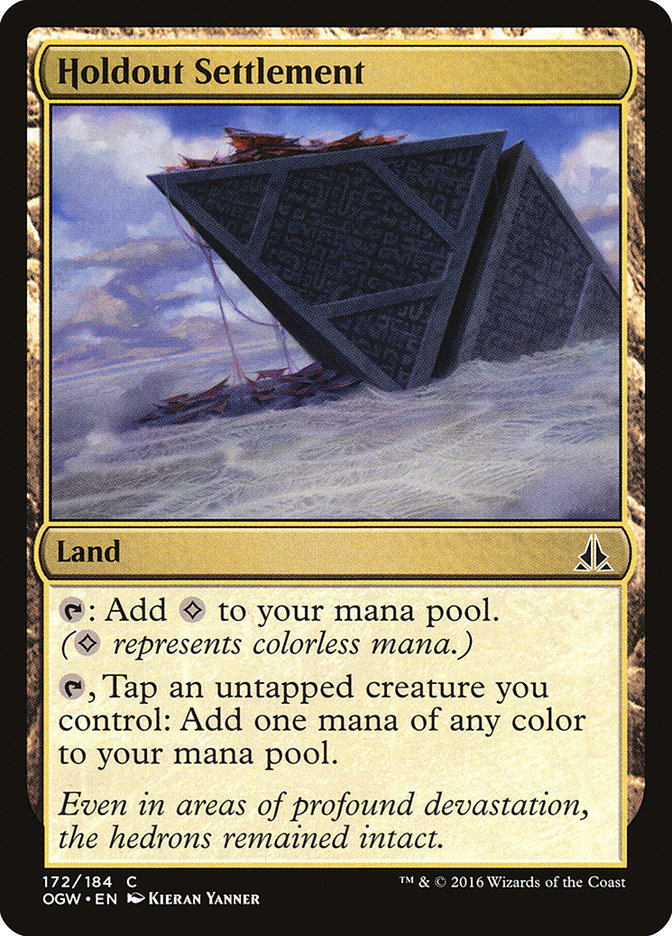Assentamento da Resistência Carta MTG
| Raridade | Comum |
| Tipo | Terreno |
| Lançamento | 2016-01-22 |
| Expansão símbolo | |
| Expansão nome | Oath of the Gatewatch |
| Expansão código | OGW |
| Número | 172 |
| Frame | 2015 |
| Layout | Normal |
| Border | Preta |
| Ilustrado por | Kieran Yanner |
Texto da carta
{T}: Adicione {C} à sua reserva de mana. ({C} representa mana incolor.) {T}: Vire uma criatura desvirada que você controle: Adicione um mana de qualquer cor à sua reserva de mana.
Mesmo em áreas de profunda devastação, os edros permaneceram intactos.
Decks que usam a carta
Decks de MTG usando Assentamento da Resistência. Aprofunde-se na estratégia dos decks, cartas de sideboard, listar ideias e exportar para jogar na ARENA ou MOL.
| # | Nome | Formato | Arquétipo | Evento |
|---|---|---|---|---|
 | Walls Combo | Pauper | Walls Combo | Pauper Challenge 32 2023-12-09 (1) |
 | Sliver Sliver Sliver | Pauper | Slivers | Tappa LP Comense Pauperissima "Road to Milano" @Magic Akiba |
 | Slivers | Pauper | Slivers | Lega Pauper Canavese - 4a Tappa Paupergeddon Winter Edition 2023 - 25 Players |
 | Naya Combo | Pauper | Boros Bully | BLUE - SAT - 1PM - Chicago Pauper Cup |
 | Walls Cascade | Pauper | Walls Cascade | Pauper League 2023-12-26 |
Texto da carta Assentamento da Resistência
{T}: Adicione {C} à sua reserva de mana. ({C} representa mana incolor.) {T}: Vire uma criatura desvirada que você controle: Adicione um mana de qualquer cor à sua reserva de mana.
Mesmo em áreas de profunda devastação, os edros permaneceram intactos.
Onde comprar
Se você deseja comprar um cartão Assentamento da Resistência MTG de um conjunto específico como Oath of the Gatewatch, há diversas opções confiáveis a serem consideradas. Uma das principais fontes é a loja de jogos local, onde muitas vezes você pode encontrar boosters, cartas individuais e decks pré-construídos de conjuntos atuais e de alguns conjuntos anteriores. Eles geralmente oferecem o benefício adicional de uma comunidade onde você pode negociar com outros jogadores.
Para um inventário mais amplo, especialmente de conjuntos mais antigos, mercados on-line como TCGPlayer, Card Kingdom e Card Market oferecem seleções extensas e permitem que você pesquise cartas de conjuntos específicos. Grandes plataformas de comércio eletrônico, como eBay e Amazon, também têm listagens de vários vendedores, o que pode ser um bom lugar para procurar produtos lacrados e achados raros.
Além disso, o site oficial do Magic geralmente tem um localizador de lojas e listas de varejistas para encontrar a Wizards of the Produtos licenciados pela Costa. Lembre-se de verificar a autenticidade e a condição dos cartões ao comprar, especialmente de vendedores individuais em mercados maiores.
Abaixo está uma lista de alguns sites de lojas onde você pode comprar os Assentamento da Resistência e outras cartas MTG:
 COMPRAR
COMPRAR BurnMana é parceiro oficial da TCGPlayer
- eBay
- Card Kingdom
- Card Market
- Star City Games
- CoolStuffInc
- MTG Mint Card
- Hareruya
- Troll and Toad
- ABU Games
- Card Hoarder Magic Online
- MTGO Traders Magic Online
Veja produtos de MTG
Legalidades
Magic the Gathering formats where Assentamento da Resistência has restrictions
| Formato | Legalidade |
|---|---|
| Commander | Válida |
| Legacy | Válida |
| Paupercommander | Válida |
| Modern | Válida |
| Oathbreaker | Válida |
| Pauper | Válida |
| Vintage | Válida |
| Duel | Válida |
| Pioneer | Válida |
Regras e informações
O guia de referência para regras de cartas de Magic: The Gathering Assentamento da Resistência fornece decisões oficiais, quaisquer erratas emitidas, bem como um registro de todas as modificações funcionais que ocorreram.
| Data | Texto |
|---|---|
| 2016-01-22 | To activate the last ability, you may tap any untapped creature you control, including one you haven’t controlled continuously since the beginning of your most recent turn. (Note that tapping the creature doesn’t use -he tap symbol].) |
